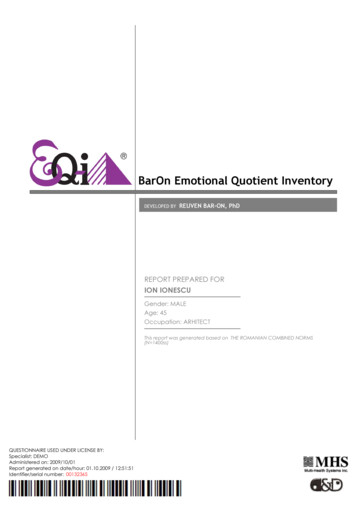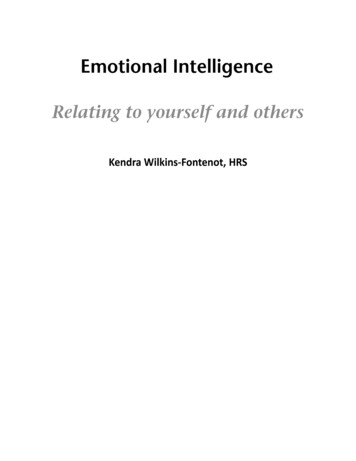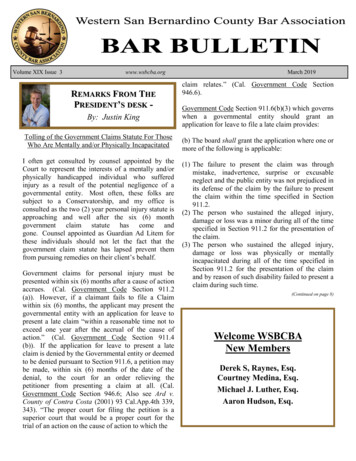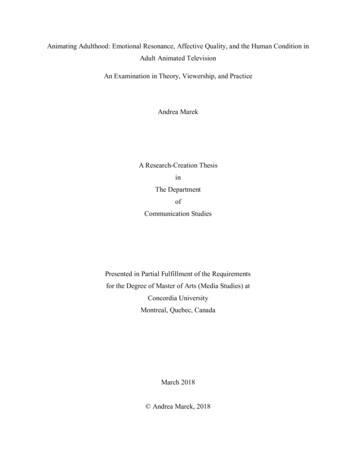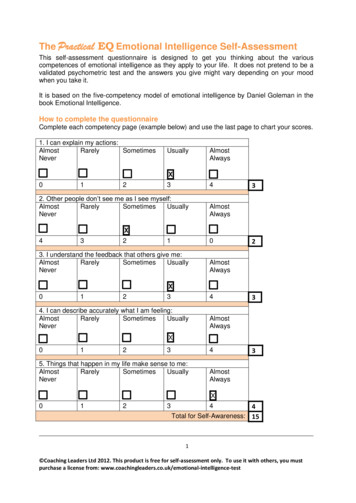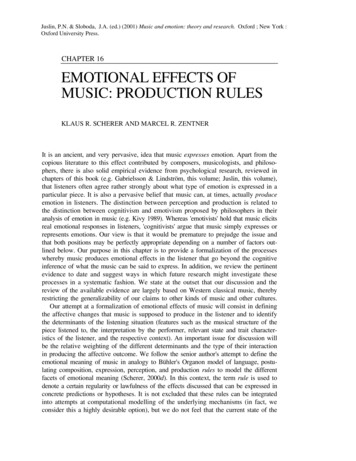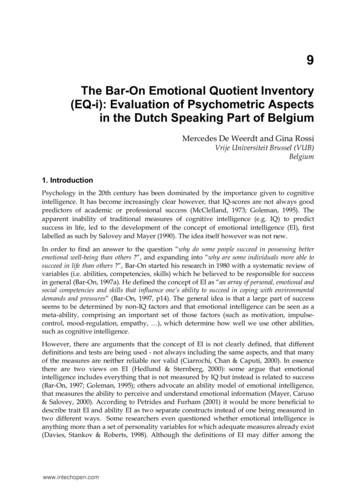
Transcription
9The Bar-On Emotional Quotient Inventory(EQ-i): Evaluation of Psychometric Aspectsin the Dutch Speaking Part of BelgiumMercedes De Weerdt and Gina RossiVrije Universiteit Brussel (VUB)Belgium1. IntroductionPsychology in the 20th century has been dominated by the importance given to cognitiveintelligence. It has become increasingly clear however, that IQ-scores are not always goodpredictors of academic or professional success (McClelland, 1973; Goleman, 1995). Theapparent inability of traditional measures of cognitive intelligence (e.g. IQ) to predictsuccess in life, led to the development of the concept of emotional intelligence (EI), firstlabelled as such by Salovey and Mayer (1990). The idea itself however was not new.In order to find an answer to the question “why do some people succeed in possessing betteremotional well-being than others ?”, and expanding into “why are some individuals more able tosucceed in life than others ?”, Bar-On started his research in 1980 with a systematic review ofvariables (i.e. abilities, competencies, skills) which he believed to be responsible for successin general (Bar-On, 1997a). He defined the concept of EI as “an array of personal, emotional andsocial competencies and skills that influence one’s ability to succeed in coping with environmentaldemands and pressures” (Bar-On, 1997, p14). The general idea is that a large part of successseems to be determined by non-IQ factors and that emotional intelligence can be seen as ameta-ability, comprising an important set of those factors (such as motivation, impulsecontrol, mood-regulation, empathy, ), which determine how well we use other abilities,such as cognitive intelligence.However, there are arguments that the concept of EI is not clearly defined, that differentdefinitions and tests are being used - not always including the same aspects, and that manyof the measures are neither reliable nor valid (Ciarrochi, Chan & Caputi, 2000). In essencethere are two views on EI (Hedlund & Sternberg, 2000): some argue that emotionalintelligence includes everything that is not measured by IQ but instead is related to success(Bar-On, 1997; Goleman, 1995); others advocate an ability model of emotional intelligence,that measures the ability to perceive and understand emotional information (Mayer, Caruso& Salovey, 2000). According to Petrides and Furham (2001) it would be more beneficial todescribe trait EI and ability EI as two separate constructs instead of one being measured intwo different ways. Some researchers even questioned whether emotional intelligence isanything more than a set of personality variables for which adequate measures already exist(Davies, Stankov & Roberts, 1998). Although the definitions of EI may differ among thewww.intechopen.com
146Psychology – Selected Papersmany researchers, instead of being contradictory to one another, they appear to becomplementary and they all share a common purpose which is to extend the traditionalview of intelligence by underlining the importance of social, emotional and personal factorsregarding intelligent behaviour (Dawda & Hart, 2000).Furthermore, some of the developed measures for EI (Bar-On, 1997; Schutte, Malouff, Hall,Haggerty, Cooper, Golden & Dornheim, 1998; Mayer, Caruso & Salovey, 1999) do includeextensive reliability and validity studies, showing reasonable to good psychometricproperties for these tests. Over the last years a growing number of scientific articles onemotional intelligence and its measures have been published (e.g. Armstrong, Galligan &Critchley, 2011; Davis & Humphrey, 2012; Qualter, Gardner, Pope, Hutchinson & Whiteley,2011; Schutte & Malouff, 2011; Zeidner, Shani-Zinovich, Matthews & Roberts, 2005),showing not only a growing interest in this concept, but also providing scientific support forsome of its measures (e.g. EQ-i - Bar-on Emotional Quotient Inventory (1997a, 1997);MSCEIT – Mayer-Salovey – Caruso Emotional Intelligence Test, 2002).In this article we focus on the Bar-on Emotional Quotient Inventory (EQ-i; Bar-on, 1997a,1997), one of the first scientific developed measures that attempts to assess EI. Bar-onworked extensively on developing a multi factorial and theoretically eclectic measure for EI,the Bar-on EQ-i, which measures the potential to succeed rather than the success itself (BarOn, 1997). According to Bar-On the core of emotional intelligence is ‘understanding oneselfand others, being able to relate to people and possessing the ability to adapt and cope withone’s surroundings’ which in term will increase one’s chances of success when dealing withenvironmental demands. Because EI renders the way in which someone applies hisknowledge to certain situations, it can also help to predict future success. (Bar-on, 1997a).An extensive body of reliability and validity research, demonstrated with samples fromseveral different countries over a period of 17 years, was published in the technical manual(Bar-on, 1997). We restrict ourselves to an overview of the most important results and werefer to the manual for more details.The reliability studies included the investigation of the internal consistency and test-retestreliability and showed good reliability. For all the subscales, the internal consistencycoefficients were high, ranging from a .69 (Social Responsibility) to .86 (Self-Regard), with anoverall average internal consistency coefficient of .76 and thus indicating a very goodhomogeneity. Results for the test-retest reliability in a South African sample showed anaverage coefficient of .85 after one month and .75 after four months. Subscales Self-Regard,Happiness and Impulse Control appeared to be more stable over time in comparison to theother subscales. (Bar-On, 1997).A principal component factor analysis was carried out by Bar-On (1997) to examine factorialvalidity. He used the criteria of eigenvalues greater than one to determine that a 13 factorsolution ‘afforded the greatest interpretability’ (p99), but of this 13 factors only the first fivefactors each explained more than 2.25% of variance (Bar-On, 1997). However, results of astudy conducted by Palmer and colleagues (2001) did not support this 13 factor structure.Instead they found a six factor solution by performing a principal axis factoring on a normalpopulation sample of 337 participants, using parallel analysis (Horn, 1965) and the scree test(Cattell, 1966) to determining the best factor solution.www.intechopen.com
The Bar-On Emotional Quotient Inventory (EQ-i):Evaluation of Psychometric Aspects in the Dutch Speaking Part of Belgium147Dawda & Hart (2000) examined the reliability and validity of the EQ-i in a sample of 243university students. Their results supported overall good reliability and validity of the EQ-iand further promoted the EQ-i as a broad measure of emotional intelligence. Nevertheless,they also suggested a limited usefulness of the intermediate EQ composite scales, due to thefact that the Interpersonal, Adaptation and Stress Management EQ scales contain subscalesthat display considerable different convergent and discriminant validity indexes. Therefore,when assessing more specific aspects of emotional intelligence, the use of the EQ subscalescores (which are mostly more internally consistent) would be more appropriate. Althoughthe EQ-i scores did not seem to be affected by response or gender bias, they consideredfurther research necessary.In order to examine Bar-On’s (1997) suggestion that emotional intelligence is an importantfactor in predicting academic success, Newsome et al (2000) tried to determine therelationship between academic achievement and emotional intelligence, personality andcognitive ability in a sample of university students. They found evidence that academicachievement could be predicted by cognitive ability and personality measures (extraversionand self-control), but their results provided no support for the incremental validity ofemotional intelligence in predicting academic achievement. Instead of rejecting the constructor hypothesis, the authors attributed the failure to establish conclusive findings to the lackof consensus on a definition of emotional intelligence and how it should be measured.Parker et al (2004) argued that a number of methodological problems more precisely the factthat Newsome used a heterogeneous group of students, could have been the reason for notfinding a relationship between academic success and emotional intelligence. O’Connor andLittle (2003) investigated whether academic success could be predicted by emotionalintelligence and found EI not to be a valid predictor. Other researchers however where inline with Bar-On’s findings (1997) and stated that emotional intelligence could indeed beconsidered to be a valid predictor for academic performance (Khajehpour, 2011; Parker,Creque, Barnhart, Harris, Majeski, Wood, Bond & Hogan, 2004; Parker, Summerfeldt,Hogan & Majeski, 2004; Parker, Hogan, Eastabrook, Oke & Wood, 2006; Qualter et al., 2011;Van der Zee, Thijs & Schakel, 2002).Numerous studies have also showed that higher levels of emotional intelligence wereassociated with a better subjective well-being and with greater life satisfaction and positiveaffect (Austin, Saklofske & Egan, 2005; Gallagher & Vella-Brodrick, 2008; Schutte, Malouff,Simunek, McKenley & Hollander, 2002; Schutte et al., 2011). Furthermore emotionalintelligence also appeared to be negatively associated with stressful events and distress.People scoring high on EI were more successful in dealing with negative life event stress(Armstrong et al., 2011). A meta-analytic study of 44 effect sizes done by Schutte, Malouff,Thorsteinsson, Bhullar & Rooke (2007) on a sample of 7898 participants showed a strongassociation between emotional intelligence and mental health. Martins, Ramalho & Morin(2010) confirmed these results in their comprehensive meta-analysis based on 105 effectsizes and 19.815 participants. Ciarrochi, Dean & Anderson (2002) investigated whether EImoderated the relationship between stress and mental health variables such as depression,hopelessness and suicidal ideation. They used emotion perception (EP) and managingother’s emotion (MOE) as EI variables. Results of their study showed that both EP and MOEmoderated the link between stress and mental health. Moreover, EP and MOE proved to bedistinct of other measures (e.g. the big five personality factors, self-esteem, trait anxiety),implying that emotional intelligence ought to be considered as a separate construct. Theirwww.intechopen.com
148Psychology – Selected Papersstudy also demonstrated the importance of EI in understanding the connection betweenmental health and stress.The construct of alexithymia (i.e. inability to express feelings with words; from Greek,namely a lack, lexis word and thymos emotion) was first introduced in the seventies byNemiah and collegues (1970) and appears to be inversely related to the construct ofemotional intelligence. Parker, Taylor and Bagby (2001) confirmed the relationship betweenthose two constructs in a community sample of adults, using the Twenty-Item TorontoAlexithymia Scale (TAS-20) and the EQ-i. Also contrary to the conclusion (that EQ-i appearsto be an unreliable self-report measurement) of Davies et al. (1998), Parker and colleagues(2001) corroborated the findings of Bar-On (1997a) and found acceptable levels of internalconsistency for all EQ-i scales. Similar studies have also demonstrated negative correlationsbetween emotional intelligence and alexithymia (Austin et al., 2005; Karimi & Besharat,2010). Finally, when exploring the relationship between emotional intelligence and theseverity of social anxiety in patients with generalised social phobia, Jacobs et al (2008)concluded that there was indeed a significant correlation between both variables.The above mentioned authors started important validation work, however, there is still aneed for more independent studies as many researchers pointed out, to further examine theconstruct validity of the measure and the relationship between emotional intelligence andother related constructs are still considered interesting topics of research (Ciarrochi et al.,2000; Hedlund et al., 2000; Bar-On, 2000; Reiff, Hatzes, Bramel & Gibbon, 2001; Derksen,Kramer & Katzko, 2002). We therefore evaluate the psychometric properties of the Dutchversion of the EQ-i (Derksen, Jeuken & Klein-Herenbrink, 1997) in a Flemish population(Flanders is the Dutch speaking part of Belgium). For this purpose the EQ-i and MinnesotaMultiphasic Personality Inventory – 2 (MMPI-2; Derksen, de Mey, Sloore, & Hellenbosch,2006) were administered to a non-clinical Flemish sample. Basic reliability was tested byCronbach Alpha and an exporatory factor analysis was carried out to examine the factorialvalidity. Convergent and divergent validity of the EQ-i with the MMPI-2 was evaluated andsome demographic aspects were used to test the EQ-i’s discriminative power between thepossible subgroups. Finally a regression analysis was used to investigate which MMPI-2variable would best predict EQ-i scores. Departing from the collected demographic data weassumed that if the EQ-i is a good measure of emotional intelligence, we should be able tosee this in the relationship between EQ-i scores and respectively educational level,employment status and degree of psychopathology (i.e. MMPI-2 profile).Research generally revealed a relationship between emotional intelligence and academicsuccess, using grade point averages as a measure of academic success (Schutte et al., 1998;Reiff, 2001; Van Der Zee et al., 2002). A study of the incremental validity of emotionalintelligence in predicting academic and social success beyond personality and academicintelligence done by Van Der Zee and collegues (2002) demonstrated that emotionalintelligence could indeed account for the additional variance. Swart’s (1996) study ofacademic success in first-year students in South-Africa showed significant
some of its measures (e.g. EQ-i - Bar-on Emotional Quotient Inventory (1997a, 1997); MSCEIT Mayer-Salovey Caruso Emotional Intelligence Test, 2002). In this article we focus on the Bar-on Emotional Quotient Inventory (EQ-i; Bar-on, 1997a, 1997), one of the first scientific developed measures that attempts to assess EI. Bar-on
